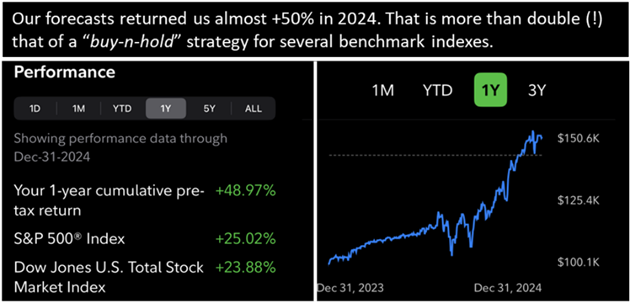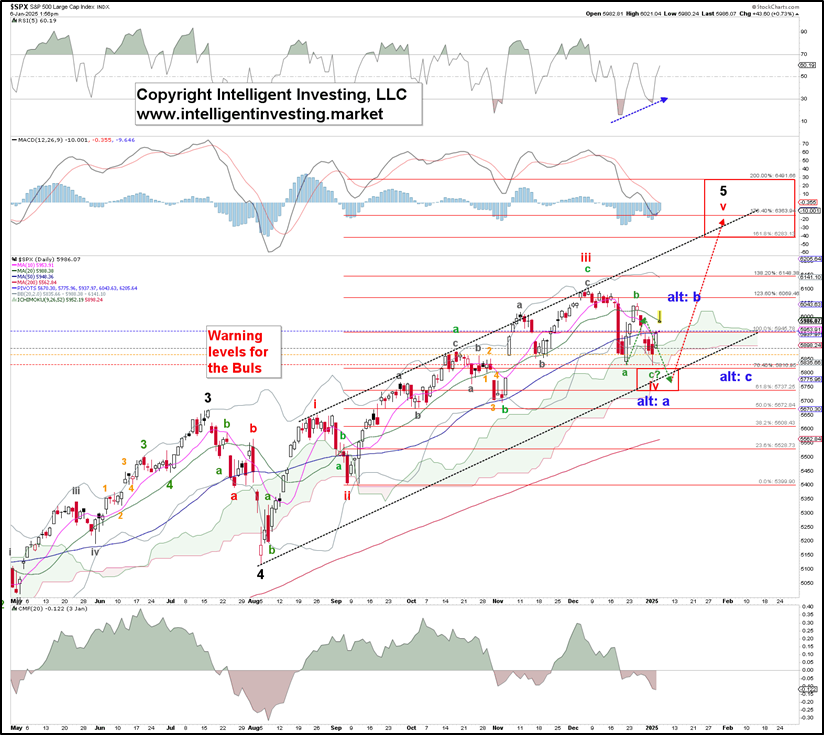Happy New Year to new and regular readers of our work. We primarily use the Elliott Wave (EW) to forecast the financial markets—in this case, the SP500 (SPX)—most likely paths forward. Although there are many ways to navigate the markets and to each their own, we find the EWP to be the most reliable and accurate. Our returns, see Figure 1 below, speak for themselves.
Figure 1. Our EWP-based trading return in 2024 for the SP500
For example, about eight (!) weeks ago we found for the SPX that
“we are looking at W-iii to reach at least SPX6060, W-iv should bottom around SPX5725, and W-v can reach at least SPX6260.”
We backed that up four weeks ago as we concluded
… we must allow it to ideally target SPX6060, possibly as high as SPX6175, before the next correction of around 5-7% can start.”
On December 19, when the index was trading at around $5900, we showed that the correction
“…should bottom out at around $5850+/-50 for a green W-a, bounce to $6000-6025 for a green W-b, and that a green W-c of the red W-iv should bottom out around $5735-5810 over the coming days before W-v can reach at least $6280.”
How did our forecasts fare?
- The index peaked on December 6 at $6099. We forecasted $6060-6175.
- It then bottomed out on December 20 at $5982. We expected $5850+/-50.
- Rallied to $6049 by December 26. We showed $6000-6025.
- The index dropped to $5829 on January 2nd. We forecasted $5735-5810.
Thus, with an accuracy of around ±2%, we reliably anticipated using the EWP where the index should top and bottom up to two months ahead. Of course, we could not know the exact path the market would take. Still, as more price data became available, we could specify the expected path, increasing our accuracy to less than ±0.5%.
Figure 2. Preferred Elliott Wave count for the SP500
We, therefore, continue to assign the index's advance since the August 2024 low an Ending Diagonal (ED) structure. As a reminder, an ED’s waves (i-ii-iii-iv-v) comprise three waves: 3-3-3-3-3 = abc-abc-abc-abc-abc. Besides, W-iii typically targets the 123.60% extension of W-i, measured from W-ii. The W-iv then tends to correct back to the 61.80% extension, after which the last W-v targets the 161.80% extension. Since, so far, the index is running a bit ahead, e.g., it held the 76.40% extension, we now anticipate it is more likely to reach the 176.40% extension at $6363. See Figure 2 above. But, as always, we will monitor the advance to narrow down the red W-v target zone.
For now, we have had a 192p rally from the January 2nd low, and as long as that low holds, we must assign the rally to the (subdividing) red W-v. The warning levels for the Bulls are marked on the daily chart, with a first warning on a break below last Friday’s close, etc.
The alternative (blue Alt: a, Alt: b, Alt: c) is that the red W-iv will become protracted, with the current rally most likely stalling out at around $6050+/-25 once again, followed by another leg lower to the red W-iv target zone. A break below the orange warning level of $5868 will strongly suggest this.
However, we slice and dice it; over the intermediate term, the index is most likely not yet done to the upside, and even after a possible last leg lower better into the ideal $5735-5810 target zone, we can still expect a rally to new all-time highs. But please note that once the $6200+ region has been reached, a much larger correction, if not an outright multi-year Bear market, can start.
The analysis is derived from data believed to be accurate, but such accuracy or completeness cannot be guaranteed. It should not be assumed that such analysis, past or future, will be profitable, equal past performance, or guarantee future performance or trends. All trading and investment decisions are the sole responsibility of the reader. The inclusion of information about positions and other information is not intended to be any type of recommendation or solicitation.
Recommended content
Editors’ Picks

AUD/USD: Extra gains need to clear 0.6400
AUD/USD rose for the third day in a row, approaching the key 0.6400 resistance on the back of the acute pullback in the US Dollar amid mounting recession concerns and global trade war fear.

EUR/USD: Powell and the NFP will put the rally to the test
EUR/USD gathered extra steam and advanced to multi-month peaks near 1.1150, although the move fizzled out somewhat as the NA session drew to a close on Thursday.

Gold looks offered near $3,100
Prices of Gold remain on the defensive on Thursday, hovering around the $3,100 region per troy ounce and retreating from earlier all-time peaks near the $3,170 level, all against the backdrop of investors' assessment of "Liberation Day".

Interoperability protocol hyperlane reveals airdrop details
The team behind interoperability protocol Hyperlane shared their upcoming token airdrop plans happening at the end of the month. The airdrop will occur on April 22, and users can check their eligibility to receive $HYPER tokens via a portal provided by the Hyperlane Foundation by April 13, the team shared in a press release with CoinDesk.

Trump’s “Liberation Day” tariffs on the way
United States (US) President Donald Trump’s self-styled “Liberation Day” has finally arrived. After four straight failures to kick off Donald Trump’s “day one” tariffs that were supposed to be implemented when President Trump assumed office 72 days ago, Trump’s team is slated to finally unveil a sweeping, lopsided package of “reciprocal” tariffs.

The Best brokers to trade EUR/USD
SPONSORED Discover the top brokers for trading EUR/USD in 2025. Our list features brokers with competitive spreads, fast execution, and powerful platforms. Whether you're a beginner or an expert, find the right partner to navigate the dynamic Forex market.





